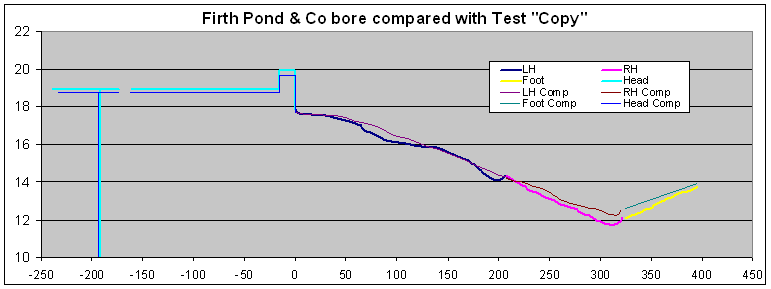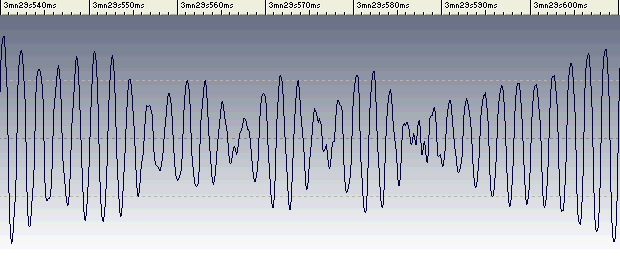A new fluteThe pitch analysis showed some of the usual irregularities but nothing I haven't dealt with before. Indeed, it positively beckoned. But did I really have time to make a new set of reamers to make this flute? Couldn't I cheat just a little? I mapped out the bore shapes and compared it with some of the other flutes I had made over the years. There were some peculiarities I couldn't hope to match without the proper reamers, but maybe they were small enough to not be critical. I didn't have to clone this flute for the purposes of initial discovery - just approximate it. If it continued to look promising, I could then make the reamers and do the job properly. Indeed, fudging it promised to give us an idea of just how accurate a copy has to be to have reasonably similar playing characteristics. A nice piece of gidgee (Acacia Cambagei) of just the right dimensions was found quivering in fear under the saw bench and was rapidly slashed into bits. The rag-tag collection of reamers converted it into a plausible approximation of the original. Although the temptation to "make a few little changes" was high, I opted to keep it similar, stupid. Grey would be back in town in a week; let's see what he thinks needs fixing before we mess with it. As is my usual practice, I opted to make a keyless version in the first instance. Much less work, just in case it turns out to be a complete dud. The Firth, Pond & Co 6-key
original in cocuswood and silver (above) You'll notice in the comparison above I've thinned the head a little on each side of the embouchure, and reduced the overhang beyond the stopper, both measures to reduce the possibility of making the flute "head heavy". This can be an issue with keyless flutes with a short foot, especially when the body is elegantly thin as with the Firth, Pond & Co. The barrel appears to be a little lower, but that was just so I could make use of my usual socket cutters. It has no acoustic implications. My appraisalSo what did I think of the copied instrument? I thought it was good. Surprisingly good volume, good intonation (a few quirks but nothing offensive and nothing that couldn't be tweaked), snappy articulation, and very good balance of volumes. Let me extrapolate on these points. VolumeIt's certainly the normal assumption that large-hole flutes are louder than small-hole flutes - they sure give that impression. We should thus expect this flute to be very quiet, and yet it's not. Hmmm ... ArticulationArticulation is all about how quickly or slowly notes will form. Or perhaps more importantly in our musical context, how precisely can ornaments such as rolls, cuts, cranns, etc be articulated? My impression is that small hole flutes are "snappier" than large holed flutes. Perhaps the changeover from "covered" to "uncovered" occurs in a shorter vertical distance, and therefore less time? More hmmm ... Balance of VolumeIt's always seemed to me that, contrary to popular 19th century opinion, a flute with identical sized holes all the way along would not display perfect balance of loudness on each note, but indeed display a gradual reduction in loudness with increasing length. The obvious example is the Boehm flute. There's no way that the lowest few notes are as loud as the top ones. And I'd expect a flute with small holes to do the reverse - the body notes will be a little subdued, but the bottom end note (which takes advantage of the whole bore diameter for venting) will honk like the proverbial gander in the proverbial pratie hole. Now that's been my supposition, but is it true? Is this the opportunity to find out? IntonationThe tuning of the original was not perfect (is it ever?). And because I was loath to make substantial changes before Grey reviewed it, neither was the copy. But it was better - I did work the undercutting harder than Firth & Pond did. What was interesting was that it seemed to need intervention a good deal less than most of the English flutes I had copied. By any yardstick, it was eminently satisfactory. (I might yet just give it a little tweak later...) Grey's appraisalSo Grey returned a week later to rejoin the fray. The obvious first thing to do was see what he thought of the copy...
You can hear Grey playing my version of his flute - The Sunny Banks. Boring issuesYou'll remember I stewed this thing up using a dodgy set of reamers. If Grey ( the original flute's owner) felt the copy was a good work-a-like of the original, this must tell us something about the level of precision needed. Just how different are these bores? Check them out on this extremely exaggerated chart. |
| We followed the standard procedure - taking results
from a sound level meter with A-weighting at a distance of 1 metre.
(A-weighting simulates the ear's response to sounds at different
pitches.)
Grey was instructed to play at the comfortable centre volume of each note - not pulling back and not pushing it to its extreme. The microphone stand directly in front of him kept him at 1M distance. The sound level meter can be seen on the tripod in front of me. |
|
Ideally we would have done this outdoors to minimise reflections from walls, floor and ceiling, but unfortunately the day was far too windy. Some of the lumps and bumps on the curves below are probably due to standing waves in one or more of the three axes of the room. None the less, as the three flutes were measured under the same conditions, the general relativity should be valid.
Ignoring the bumps then and looking for trends, we note that all three flutes follow the same general pattern - a reasonably flat response above F natural and a diminishing response below it. Even that could be a room effect, indicating reducing support for lower frequencies below the room's "cut-off" frequency. But the important thing to note is that the small holed Firth, Pond & Co (pink trace) is not significantly quieter than its bigger sisters.
Tabulating the results:
| Flute: | Firth Pond & Co | Medium Rudall Copy | Pratten's Perfected Copy |
| Loudest Note | 86 dBA | 86 dBA | 88 dBA |
| Quietest Note | 72 dBA | 70 dBA | 72 dBA |
| Average loudness | 79 dBA | 79 dBA | 81 dBA |
| Range of loudness | 14 dB | 17 dB | 16 dB |
We can see that the Pratten's copy ends up an average 2dB louder, while the other two were very similar. Keep in mind that 1dB is the smallest change detectable by a trained listener on a constant tone, and three dB is the smallest change detectable in normal program material (eg music) for the average listener. An apparent doubling of sound intensity is 10dB. In the light of those definitions a 2dB change is not very significant.
Indeed, it isn't enough to explain the perceived difference in loudness of the Pratten's and the Firth, Pond & Co. We have to assume for the moment that the difference is mostly timbrel in nature, although a quick comparison of the spectra of notes played on each instrument did not reveal anything startling. Clearly a lot more work needs to be done here. It is important that we can understand what influences our perception of loudness and fullness in a flute, and what characteristics of the flute contribute to that perception.
The range of loudness (difference between the loudest and quietest notes) seems to bear out the perception that this small-holed flute has a better balance of volume across its range than either of its bigger sisters. More work is needed to confirm this with a series of measurements taken under better acoustic conditions.



